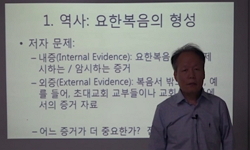지금까지 마가복음에 나타난 예수의 자기이해로서 인자 칭호에 대하여 살펴보았다. 본 연구에서는 마가복음을 기록했을 당시의 삶의 자리와 사회적인 상황은 어떠했으며 저자가 어떤 목적...
http://chineseinput.net/에서 pinyin(병음)방식으로 중국어를 변환할 수 있습니다.
변환된 중국어를 복사하여 사용하시면 됩니다.
- 中文 을 입력하시려면 zhongwen을 입력하시고 space를누르시면됩니다.
- 北京 을 입력하시려면 beijing을 입력하시고 space를 누르시면 됩니다.
https://www.riss.kr/link?id=T11592402
- 저자
-
발행사항
천안 : 호서대학교 연합신학전문대학원, 2008
-
학위논문사항
학위논문(석사) -- 호서대학교 연합신학전문대학원 , 성서신학과 신약학전공 , 2008
-
발행연도
2008
-
작성언어
한국어
- 주제어
-
DDC
226.3 판사항(21)
-
발행국(도시)
충청남도
-
형태사항
124p. ; 26cm
-
일반주기명
참고문헌: p.111-121
- 소장기관
-
0
상세조회 -
0
다운로드
부가정보
국문 초록 (Abstract)
Ⅱ장에서는 마가복음 저자의 기록동기와 예수의 정체성을 나타내는 기독론 칭호들을 살펴보고, 예수의 자기 이해로서의 ‘인자’ 칭호의 의미와 그 배경을 고찰해 보았다. 마가의 공동체는 유대전쟁을 전후하여 갈등과 다양한 고난의 상황들 속에서 거짓 예언자들이 일어나고 예루살렘 성전의 파괴 그리고 대중적인 메시야 운동이 확대되어지고 유대교 회당과의 마찰로 인한 새로운 정체성의 위기에 직면해 있었다. 마가는 그들의 시련을 신학적으로 이해하기를 원했고 수난 받는 자신의 공동체에게 예수의 정체성에 대하여 설명할 필요가 있었다.
마가는 예수의 정체성을 이야기하면서 유대교적인 전통적 메시야 관을 버리고 기독교의 새로운 그리스도 관을 제시하고 있으며 정치적 해방자로서의 그리스도 칭호의 잘못된 이해를 거부하고 십자가에서 죽는 ‘하나님의 아들’ 칭호(15:39)와 십자가에서 죽은 그가 권능과 영광으로 다시 오시는 ‘인자’ 칭호를 그 대안으로 제시하고 있다(14:62). 그것은 어떤 다른 칭호가 대신 할 수 없는 방법으로 고난과 영광의 요소를 결합시켰다. 마가에게 ‘인자’는 예수에 대한 이해에 있어서 본질적인 것으로 이 칭호가 예수 자신을 가리키는 말이자 메시야적인 칭호로서의 기능을 하는 용어였다. 인자 칭호는 예수의 전체적인 사명에 알맞은 것이었다. 인자 칭호는 예수 자신이 스스로를 가리키는 칭호(self-designation)로서 유일하게 선택하였다. 그것은 정치적 의미와는 상관없는 것이었고 그래서 잘못된 기대를 방지해 주는 것이었다.
Ⅲ장에서는 주된 연구로 ‘인자’ 칭호에 해당되는 마가복음의 본문을 주석적 방법으로 분석 하였다. 구약성서 안에서 ‘인자’(ben adam)라는 의미의 용어는 두 가지로 나타나는데 하나는 에스겔서에 일상적인 용법으로 ‘사람’을 나타내는 ‘인자’(ben adam)이고, 다른 하나는 아람어로 집합명사의 인간을 의미하기도 하고 단수로 한 개인을 의미하기도 하는 다니엘 7:13의 ‘인자 같은 이’(bar enash) 곧 사람 모습을 닮은 어떤 사람이다. 다니엘서의 ‘인자 같은 이’의 표상은 다니엘 7:13에 예언자, 메시야, 왕, 제사장, 천사 등의 복합적 이미지를 지닌 인자를 묵시적으로 소개하고 있다.
인자는 다니엘 7:13에서 영향을 받은 것으로 분명히 예수의 메시야적 자기 이해에 있어서 핵심이었다. 인자가 구름타고 오는 것은 그가 천상적이고 신적인 존재임을 나타내는 것이다(사 19:1; 시 18:12; 출 34:5). 여기에서 ‘옛적부터 항상 계신 이’는 ‘인자 같은 이’에게 권세와 영광, 그리고 나라를 준다. 인자가 세우는 나라는 지상 왕국이다. 심판 후에 인자 같은 이에게 종말적 나라에 대한 영원한 통치권이 수여된다. 인자의 신성을 나타내는 영광은(단 7:14) “그 아버지의 영광이다.” 따라서 천상적 존재인 인자가 하나님의 아들 예수로서 분명히 인식된다. 다니엘의 환상 중에 중요한 두 가지 측면이 있는데 하나는 구름을 타고 오는 미래성과 다른 하나는 ‘성도’가 영광을 받기 이전에 먼저 고난을 당해야 한다는 사실이다. 사람의 모양으로 낮아져 섬김 속에서, 죽기까지의 고난 속에서, 생명으로의 부활 속에서, 영광중의 파루시아 속에서, 그는 하나님 나라의 중보자이며 하나님의 대표자이며 사람의 대표자이다.
Ⅳ장은 이상의 연구를 토대로 마가의 신학적 입장과 그가 처한 삶의 자리에서 예수의 자기이해로서의 ‘인자’ 칭호의 위치를 연구하였다. 인자 칭호는 예수 그리스도의 지상에서의 특별한 사역과 수난과 부활 및 미래 지상에 도래하는 그리스도의 묵시적 모습을 나타내는 중요한 칭호이며 복음서에서 주로 사용되어지고 있음을 발견하게 된다.
마가복음의 예수는 자신을 명시적으로 ‘그리스도’나 ‘하나님의 아들’로 부르거나 혹은 불리어지는 것을 꺼려했다. 다시 말해서 예수께서 그와 같은 칭호나 용어의 사용이 자기의 신분과 사명에 대하여 오해를 불러일으킬 수 있었기 때문이었다. 그러므로 마가복음에서 거부된 그리스도 칭호는 정치적 해방자로서의 기능적인 측면이지 예수 그리스도 자체가 거부된 것은 결코 아니었다. 마가복음의 예수는 ‘그리스도’라는 칭호를 사용하는데 대한 교정으로 제시된 것으로 보이는 ‘인자’에 대한 언급으로 대신하였다(8:31; 14:62).
마가는 유대 메시야를 능가하는 예수에 대한 새로운 메시야 상을 제시한다(12:35-37). 마가는 그의 독자들로 하여금 예수님이 사무엘하 7장과 시편 2편을 통합한 개념을 초월하는 독특한 개념의 ‘하나님의 아들’이자 ‘메시야’라는 사실을 알도록 한다. 그분의 가르침과 치유 사역이 입증하는 바와 같이 예수님은 귀신 들린 자, 영원히 부정한 자, 이방인들, 그리고 스스로 죄인이라고 여기는 자들에
지금까지 마가복음에 나타난 예수의 자기이해로서 인자 칭호에 대하여 살펴보았다. 본 연구에서는 마가복음을 기록했을 당시의 삶의 자리와 사회적인 상황은 어떠했으며 저자가 어떤 목적으로 본문을 기록하였는지를 살펴보고 ‘인자’ 칭호 본문을 주석하여 마가복음에 나타난 예수의 자기 이해로서의 인자 칭호의 독특성과 의미를 밝히려고 하였다.
Ⅱ장에서는 마가복음 저자의 기록동기와 예수의 정체성을 나타내는 기독론 칭호들을 살펴보고, 예수의 자기 이해로서의 ‘인자’ 칭호의 의미와 그 배경을 고찰해 보았다. 마가의 공동체는 유대전쟁을 전후하여 갈등과 다양한 고난의 상황들 속에서 거짓 예언자들이 일어나고 예루살렘 성전의 파괴 그리고 대중적인 메시야 운동이 확대되어지고 유대교 회당과의 마찰로 인한 새로운 정체성의 위기에 직면해 있었다. 마가는 그들의 시련을 신학적으로 이해하기를 원했고 수난 받는 자신의 공동체에게 예수의 정체성에 대하여 설명할 필요가 있었다.
마가는 예수의 정체성을 이야기하면서 유대교적인 전통적 메시야 관을 버리고 기독교의 새로운 그리스도 관을 제시하고 있으며 정치적 해방자로서의 그리스도 칭호의 잘못된 이해를 거부하고 십자가에서 죽는 ‘하나님의 아들’ 칭호(15:39)와 십자가에서 죽은 그가 권능과 영광으로 다시 오시는 ‘인자’ 칭호를 그 대안으로 제시하고 있다(14:62). 그것은 어떤 다른 칭호가 대신 할 수 없는 방법으로 고난과 영광의 요소를 결합시켰다. 마가에게 ‘인자’는 예수에 대한 이해에 있어서 본질적인 것으로 이 칭호가 예수 자신을 가리키는 말이자 메시야적인 칭호로서의 기능을 하는 용어였다. 인자 칭호는 예수의 전체적인 사명에 알맞은 것이었다. 인자 칭호는 예수 자신이 스스로를 가리키는 칭호(self-designation)로서 유일하게 선택하였다. 그것은 정치적 의미와는 상관없는 것이었고 그래서 잘못된 기대를 방지해 주는 것이었다.
Ⅲ장에서는 주된 연구로 ‘인자’ 칭호에 해당되는 마가복음의 본문을 주석적 방법으로 분석 하였다. 구약성서 안에서 ‘인자’(ben adam)라는 의미의 용어는 두 가지로 나타나는데 하나는 에스겔서에 일상적인 용법으로 ‘사람’을 나타내는 ‘인자’(ben adam)이고, 다른 하나는 아람어로 집합명사의 인간을 의미하기도 하고 단수로 한 개인을 의미하기도 하는 다니엘 7:13의 ‘인자 같은 이’(bar enash) 곧 사람 모습을 닮은 어떤 사람이다. 다니엘서의 ‘인자 같은 이’의 표상은 다니엘 7:13에 예언자, 메시야, 왕, 제사장, 천사 등의 복합적 이미지를 지닌 인자를 묵시적으로 소개하고 있다.
인자는 다니엘 7:13에서 영향을 받은 것으로 분명히 예수의 메시야적 자기 이해에 있어서 핵심이었다. 인자가 구름타고 오는 것은 그가 천상적이고 신적인 존재임을 나타내는 것이다(사 19:1; 시 18:12; 출 34:5). 여기에서 ‘옛적부터 항상 계신 이’는 ‘인자 같은 이’에게 권세와 영광, 그리고 나라를 준다. 인자가 세우는 나라는 지상 왕국이다. 심판 후에 인자 같은 이에게 종말적 나라에 대한 영원한 통치권이 수여된다. 인자의 신성을 나타내는 영광은(단 7:14) “그 아버지의 영광이다.” 따라서 천상적 존재인 인자가 하나님의 아들 예수로서 분명히 인식된다. 다니엘의 환상 중에 중요한 두 가지 측면이 있는데 하나는 구름을 타고 오는 미래성과 다른 하나는 ‘성도’가 영광을 받기 이전에 먼저 고난을 당해야 한다는 사실이다. 사람의 모양으로 낮아져 섬김 속에서, 죽기까지의 고난 속에서, 생명으로의 부활 속에서, 영광중의 파루시아 속에서, 그는 하나님 나라의 중보자이며 하나님의 대표자이며 사람의 대표자이다.
Ⅳ장은 이상의 연구를 토대로 마가의 신학적 입장과 그가 처한 삶의 자리에서 예수의 자기이해로서의 ‘인자’ 칭호의 위치를 연구하였다. 인자 칭호는 예수 그리스도의 지상에서의 특별한 사역과 수난과 부활 및 미래 지상에 도래하는 그리스도의 묵시적 모습을 나타내는 중요한 칭호이며 복음서에서 주로 사용되어지고 있음을 발견하게 된다.
마가복음의 예수는 자신을 명시적으로 ‘그리스도’나 ‘하나님의 아들’로 부르거나 혹은 불리어지는 것을 꺼려했다. 다시 말해서 예수께서 그와 같은 칭호나 용어의 사용이 자기의 신분과 사명에 대하여 오해를 불러일으킬 수 있었기 때문이었다. 그러므로 마가복음에서 거부된 그리스도 칭호는 정치적 해방자로서의 기능적인 측면이지 예수 그리스도 자체가 거부된 것은 결코 아니었다. 마가복음의 예수는 ‘그리스도’라는 칭호를 사용하는데 대한 교정으로 제시된 것으로 보이는 ‘인자’에 대한 언급으로 대신하였다(8:31; 14:62).
마가는 유대 메시야를 능가하는 예수에 대한 새로운 메시야 상을 제시한다(12:35-37). 마가는 그의 독자들로 하여금 예수님이 사무엘하 7장과 시편 2편을 통합한 개념을 초월하는 독특한 개념의 ‘하나님의 아들’이자 ‘메시야’라는 사실을 알도록 한다. 그분의 가르침과 치유 사역이 입증하는 바와 같이 예수님은 귀신 들린 자, 영원히 부정한 자, 이방인들, 그리고 스스로 죄인이라고 여기는 자들에
다국어 초록 (Multilingual Abstract)
The introduction discloses the purpose, methods, and extent of the study and examines the existent research on the Christology in the Gospel of Mark.
This study is aimed to look for Sitz im Leben and social conditions at times of the Gospel of Mark when it was written. I also observe how the author of the Gospel, Mark attempted to clarify characteristics and significance of the title ‘Son of Man’ as Jesus' self-identification in the Gospel by exegetic work on the text where the designation ‘Son of Man’ appears.
In chapter Ⅱ, I deal with Mark's motive to write the Gospel of Mark and his usage of Christological designations which represents Jesus'self- identification and consider significance of the title in its context. Markan community was at the moment of specific crisis because they are suffered for various reasons; the emergence of false prophets, the destruction of temple of Jerusalem, the expansion of Messianic movement and the conflict with Jewish synagogues. As Mark talked about Jesus' identification, he suggested new Christological view of Christianity instead of dealing with Jewish traditional Messianic view. At the same time, Mark denies having wrong understanding of the title of Christ as a political liberator. In stead, he used the title ‘Son of God’ to represent the crucified Christ. On the other hand, he used the ‘Son of Man’ to demonstrate the returning Christ with power and glory. ‘Son of Man’ is the proper title regarding Jesus' entire ministry. Jesus selected the title ‘Son of Man’ for His self-designation. It had no connection with political significance. Jesus could keep himself away from wrong expectation of people in the title.
In chapter Ⅲ, I mainly focus on exegetical study to analyze the title in the text. In the Old Testament, ‘Son of Man’(ben adam) can be meant into two dimensions. One is a common usage from the book of Ezekiel, meaning ‘a man’(ben adam). The other one is either human being as a collective noun in Aramic or ‘an individual’ in singular in Daniel 7:13(bar enash). In the book of Daniel, the symbol of ‘someone who looks like a man’ introduces us multifarious images of ‘Son of Man’ like a prophet, messiah, king, priest, angel and so on in eschatological aspect.
The title ‘Son of Man’ is delineated from Daniel 7:13. It was the kernel in understanding of Jesus'Messianic identification of Himself. Coming ‘Son of Man’ on the clouds tells us that He is a heavenly and a godly being(Judges 19:1; Psalms 18:12; Exodus 34:5). At this point of view, ‘someone who looks like a man’ was given authority, glory and a kingdom by the 'Ancient One.' The kingdom of ‘Son of Man’ will be built on the earth. After judgment, He will be given eternal royal power over the eschatological kingdom.
In chapter Ⅵ, I explore the title in relation to Mark's Sitz im Leben. The title Son of Man is viewed as important designation which shows Jesus Christ's eschatological figures implying His unique earthly ministries, crucifixion, resurrection and the advent in futuristic aspect. It is mainly used in the Gospels. Obviously Jesus in the Mark did not prefer to be called as neither ‘Christ’ nor ‘Son of God.’ In other words, since it could cause misunderstanding of His social position and His commission. Mark substituted ‘Son of Man’ for the title ‘Christ’ to avoid misunderstanding of Jesus' identity.
Mark suggested new Messianic figure of Jesus which is superior to the Jewish Messiah(12:35-37). Mark let his readers realize that Jesus has to be understood not only as the ‘Son of God’ but also and the ‘messiah’ of the unique idea going beyond common idea of integrated figure of Daniel 7 and the Psalms 2. Moreover, Jesus came to us to serve many and not to be served by them giving His life as a redemption(10:45; 14:24).
Climax of Jesus ministry is at the moment of His death on the Cross. He wanted to sacrifice himself as a redemptive sacrifice through His obedient and devoted lives. Son of Man is willing to be suffered. It is an ironical statement to be a suffered messiah. Mark applies the title “Son of Man” to teach Jesus' disciples human suffering as well as divine authority. Now Jesus, Son of Man became a superior being who will come with glory and authority at the end of days.
The purpose of this study is to reveal the significance of the Christological title ‘Son of Man’ in the Gospel of Mark. I have so far examine the designation of Jesus as His identification of himself in the Gospel of Mark. This study unfolds as fo...
The purpose of this study is to reveal the significance of the Christological title ‘Son of Man’ in the Gospel of Mark. I have so far examine the designation of Jesus as His identification of himself in the Gospel of Mark. This study unfolds as follows.
The introduction discloses the purpose, methods, and extent of the study and examines the existent research on the Christology in the Gospel of Mark.
This study is aimed to look for Sitz im Leben and social conditions at times of the Gospel of Mark when it was written. I also observe how the author of the Gospel, Mark attempted to clarify characteristics and significance of the title ‘Son of Man’ as Jesus' self-identification in the Gospel by exegetic work on the text where the designation ‘Son of Man’ appears.
In chapter Ⅱ, I deal with Mark's motive to write the Gospel of Mark and his usage of Christological designations which represents Jesus'self- identification and consider significance of the title in its context. Markan community was at the moment of specific crisis because they are suffered for various reasons; the emergence of false prophets, the destruction of temple of Jerusalem, the expansion of Messianic movement and the conflict with Jewish synagogues. As Mark talked about Jesus' identification, he suggested new Christological view of Christianity instead of dealing with Jewish traditional Messianic view. At the same time, Mark denies having wrong understanding of the title of Christ as a political liberator. In stead, he used the title ‘Son of God’ to represent the crucified Christ. On the other hand, he used the ‘Son of Man’ to demonstrate the returning Christ with power and glory. ‘Son of Man’ is the proper title regarding Jesus' entire ministry. Jesus selected the title ‘Son of Man’ for His self-designation. It had no connection with political significance. Jesus could keep himself away from wrong expectation of people in the title.
In chapter Ⅲ, I mainly focus on exegetical study to analyze the title in the text. In the Old Testament, ‘Son of Man’(ben adam) can be meant into two dimensions. One is a common usage from the book of Ezekiel, meaning ‘a man’(ben adam). The other one is either human being as a collective noun in Aramic or ‘an individual’ in singular in Daniel 7:13(bar enash). In the book of Daniel, the symbol of ‘someone who looks like a man’ introduces us multifarious images of ‘Son of Man’ like a prophet, messiah, king, priest, angel and so on in eschatological aspect.
The title ‘Son of Man’ is delineated from Daniel 7:13. It was the kernel in understanding of Jesus'Messianic identification of Himself. Coming ‘Son of Man’ on the clouds tells us that He is a heavenly and a godly being(Judges 19:1; Psalms 18:12; Exodus 34:5). At this point of view, ‘someone who looks like a man’ was given authority, glory and a kingdom by the 'Ancient One.' The kingdom of ‘Son of Man’ will be built on the earth. After judgment, He will be given eternal royal power over the eschatological kingdom.
In chapter Ⅵ, I explore the title in relation to Mark's Sitz im Leben. The title Son of Man is viewed as important designation which shows Jesus Christ's eschatological figures implying His unique earthly ministries, crucifixion, resurrection and the advent in futuristic aspect. It is mainly used in the Gospels. Obviously Jesus in the Mark did not prefer to be called as neither ‘Christ’ nor ‘Son of God.’ In other words, since it could cause misunderstanding of His social position and His commission. Mark substituted ‘Son of Man’ for the title ‘Christ’ to avoid misunderstanding of Jesus' identity.
Mark suggested new Messianic figure of Jesus which is superior to the Jewish Messiah(12:35-37). Mark let his readers realize that Jesus has to be understood not only as the ‘Son of God’ but also and the ‘messiah’ of the unique idea going beyond common idea of integrated figure of Daniel 7 and the Psalms 2. Moreover, Jesus came to us to serve many and not to be served by them giving His life as a redemption(10:45; 14:24).
Climax of Jesus ministry is at the moment of His death on the Cross. He wanted to sacrifice himself as a redemptive sacrifice through His obedient and devoted lives. Son of Man is willing to be suffered. It is an ironical statement to be a suffered messiah. Mark applies the title “Son of Man” to teach Jesus' disciples human suffering as well as divine authority. Now Jesus, Son of Man became a superior being who will come with glory and authority at the end of days.
목차 (Table of Contents)
- Ⅰ. 서론 = 1
- A. 연구목적과 중요성 = 1
- B. 연구범위와 방법 = 4
- C. 연구사 = 9
- Ⅱ. 마가복음의 기록동기와 인자 칭호의 중요성 = 18
- Ⅰ. 서론 = 1
- A. 연구목적과 중요성 = 1
- B. 연구범위와 방법 = 4
- C. 연구사 = 9
- Ⅱ. 마가복음의 기록동기와 인자 칭호의 중요성 = 18
- A. 마가복음의 위치와 기록동기 = 18
- B. 인자 칭호의 성서적 의미와 용례 = 27
- C. 마가복음에 나타난 기독론 칭호와 그 중요성 = 34
- Ⅲ. 본문 주석 = 51
- A. 예수의 자기 칭호로서의 인자(2:10, 28) = 51
- B. 고난당하고 부활하실 메시야 인자(8:31; 9:9,12,31;10:33-34, 45; 14:21, 41) = 56
- C. 영광과 권능으로 오실 인자(8:38; 13:26; 14:62) = 77
- Ⅳ. 예수의 자기 이해와 인자 기독론 = 83
- A. 역설적 인자 메시야 예수의 사역 = 83
- B. 더 강한 자 · 승리자이신 인자 예수 = 89
- C. 종말론적 공동체의 머리이신 인자 예수 = 96
- Ⅴ. 결론 = 103
- A. 요약 및 과제 = 103
- B. 적용 및 전망 = 106
- 참고문헌 = 111
- ABSTRACT = 122












